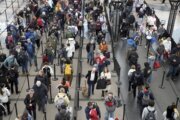NEW YORK (AP) — Wall Street climbed back to its best level in 20 months on Friday following a stronger-than-expected report on the U.S. job market.
The S&P 500 rose 0.4%, enough to clinch a sixth straight winning week for the index, which is its longest such streak in four years. Wall Street’s main measure of health is now just 4% below its record set at the start of last year.
The Dow Jones Industrial Average rose 130 points, or 0.4%, and the Nasdaq composite gained 0.4%.
Yields rose more sharply in the bond market following the report, which said U.S. employers added more jobs last month than economists expected. Workers’ wages also rose more than expected, and the unemployment rate unexpectedly improved.
The strong data keep at bay worries about a possible recession, at least for a while longer, and stocks of some companies whose profits are closely tied to the strength of the economy rallied. Energy-related stocks had the biggest gain of the 11 sectors that make up the S&P 500, rising 1.1% as oil prices strengthened amid hopes for more demand for fuel.
Carrier Global climbed 4.5% for one of the market’s bigger gains after it said it agreed to sell its security business, Global Access Solutions, to Honeywell for $4.95 billion.
But the worry on Wall Street is that the remarkably resilient job market could also end up giving inflation more fuel. That could push the Federal Reserve to either raise its main interest rate further or at least keep it at its highest level since 2001 for longer than expected.
That in turn could dilute the central hope driving the stock market recently: Inflation has come down enough from its peak two summers ago for the Fed to finally halt its hikes to interest rates and begin cutting them next year.
“The Fed is so afraid of ‘giving up before the job is done’ that it will err on the side of overdoing it,” said Brian Jacobsen, chief economist at Annex Wealth Management.
Overall, the job data looked decent, Bank of America economists said in a BofA Global Research report. They said the numbers back up their expectation “that economic activity will slow, not crash.”
The yield on the 10-year Treasury rose to 4.22% from 4.15% late Thursday. It had been on a general decline and relaxing the pressure on stocks since topping 5% in October, when it reached its highest level since 2007.
The yield on the two-year Treasury, which more closely follows expectations for the Fed, rose to 4.72% from 4.60% as traders pulled back on bets for how many times the Fed could cut rates in 2024.
High rates and yields hurt all kinds of investments, and they pack a particularly hard punch on stocks seen as the most expensive or requiring their investors to wait a long time for big growth.
Google’s parent company, Alphabet, slipped 1.4% and was the heaviest weight on the S&P 500. A day earlier, it had leaped amid excitement about the launch of its latest artificial-intelligence offering. Other Big Tech stocks were stronger, with Nvidia, Apple and Microsoft all rising.
Also on the losing end was RH. The home furnishings company slumped 14% after reporting weaker results for the latest quarter than analysts expected.
All told, the S&P 500 rose 18.78 points to 4,604.37. The Dow added 130.49 to 36,247.87, and the Nasdaq climbed 63.98 to 14,403.97.
Friday’s jobs report is one of the last major pieces of data the Fed will get before it announces its next move on interest rates Wednesday. On Tuesday, the U.S. government will give the latest monthly update on how high inflation is for U.S. consumers.
The widespread expectation is still for the Fed to hold its main interest rate steady next week, according to data from CME Group. But traders are now betting on less than a 46% chance the Fed will have cut rates by March. That’s down from nearly 65% a day earlier.
A separate preliminary report on Friday offered more encouragement. It said that U.S. consumers’ expectations for inflation in the coming year dropped to 3.1% from 4.5% a month earlier, the lowest since March 2021. The Fed has said it pays attention to such expectations, fearing a rise could lead to a vicious cycle that keeps inflation high.
The preliminary report from the University of Michigan also said sentiment among consumers strengthened enough to erase all its declines from the prior four months, mainly because of improved expectations for inflation.
In the oil market, crude prices rose to recover some of their sharp losses in recent months. A barrel of benchmark U.S. oil gained $1.89 to settle at $71.23, though it’s still more than $20 below where it was in September. It’s been tumbling on worries that demand from the global economy won’t be strong enough to absorb all the world’s available supplies.
Brent crude, the international standard, rose $1.79 to $75.84 per barrel.
In stock markets abroad, indexes were mostly higher in Europe and mixed in Asia. The Nikkei 225 tumbled 1.7% for a second straight drop amid speculation about whether the Bank of Japan will ease off its ultra-easy policy on interest rates.
___
AP Business Writer Zimo Zhong contributed.
Copyright © 2024 The Associated Press. All rights reserved. This material may not be published, broadcast, written or redistributed.





